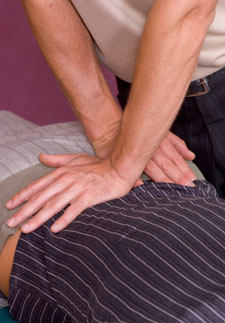Chiropractic Structural Corrections Are Essential

King of Prussia Structural Corrections
Spinal joints that aren’t moving right can choke or irritate nearby nerves. Chiropractic structural corrections add motion to these stuck joints, reducing nervous system disruption. Then, health has the best opportunity to return.
Many Techniques
Sometimes a specific, highly-accurate thrust is used. Or an instrument delivers carefully directed energy. Or a slow, constant pressure is used. Several areas may be corrected, or just one. Sometimes a popping sound is heard.

Chiropractic structural correction at Marini Family Chiropractic
Feels Great
Because we rely on structural corrections to help your body “right itself”, we’re highly proficient. Most patients report a sense of well-being and ease. After all, if structural corrections weren’t pleasant, our patients wouldn’t return for the multiple visits needed to retrain their spine!
Everyone Benefits
Newborns, infants, children, seniors and even back surgery patients can get corrections. Naturally, structural corrections are tailored to your size, age and particular health issue. Find out for yourself by scheduling a no-obligation consultation to discuss your problem.
Frequently Asked Questions:
- Are chiropractic structural corrections safe?
Yes. A New Zealand government study found that structural corrections are “remarkably safe.” Chiropractic care enjoys an excellent track record. A thorough exam can identify the rare person for whom chiropractic care might be unsuited.
- Will structural corrections make my spine too loose?
No. Only the spinal joints that are “locked up” receive structural corrections. The occasional spinal joints that move too much, are passed over so weakened muscles and ligaments can stabilize and heal.
- How many structural corrections will I need?
The number of structural corrections varies with each patient and their individual health goals. Many patients sense some progress within a week or two of frequent visits. Visits are less often as your spine stabilizes. In difficult cases, complete healing can take months or even years.
- Why would a newborn get structural corrections?
Even today’s “natural” childbirth methods can affect an infant’s spine. Colic, unusual crying, poor appetite or erratic sleeping habits can be signs of spinal distress. Structural corrections are gentle. Knowing exactly where to correct, no more pressure than you’d use to test the ripeness of a tomato is involved.
- Can I correct myself?
No. Some people can make their joints “pop” but that’s not an correction! Structural corrections are specific and take years to master. Even your chiropractor must consult a colleague to benefit from chiropractic care.
- What does an structural correction feel like?
Most patients report a sense of well-being or a feeling of calmness. Since repeated structural corrections are necessary, if structural corrections didn’t feel good, patients wouldn’t return to finish their care. Chiropractors are experts at making structural corrections feel good.
- Can patients with osteoporosis get chiropractic care?
Of course. When developing a care plan, your chiropractor considers the unique circumstances of each patient. There are many ways to structural correct the spine. The method selected will be best suited to your age, size and spinal problem.
- Isn’t some back pain normal?
Pain of any kind, at any age, is a sign that something isn’t right. Pain is the way your body signals that a limit has been reached or a problem has developed. Since we can adapt, minor aches and pains are often shrugged off. While they may go away, if the underlying problem remains unattended, the problem can slowly worsen until it becomes more difficult and expensive to resolve.
- Can I have chiropractic care after back surgery?
Yes. Rest assured that we will avoid the surgically modified areas of your spine. However, surgery may produce compensation reactions either above or below the involved level. If necessary, these other areas will be the focus of your chiropractic care.
 Request Appointment
Request Appointment Email Us
Email Us

